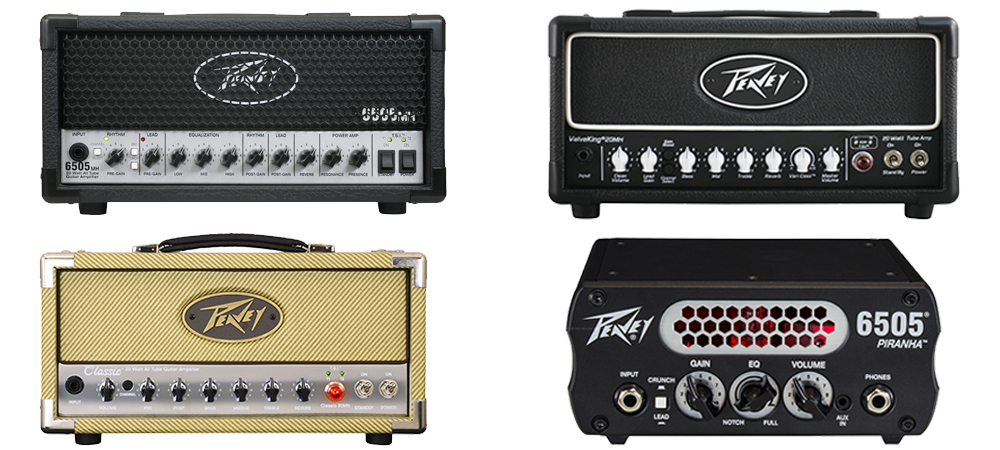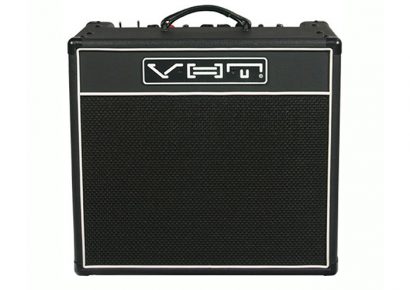OLD FRIEND
The first real (read: not a 10w squawk box) amp I ever owned was a Peavey Bandit 112. As a result, I’ve always had a soft spot for the simplicity and flexibility that made these builds as reliable as they always have been. This in mind, I jumped at the chance to sink my teeth into the latest innovation from the creators of an old favourite.
THE 6505
The ‘6505’ logo has been the real breadwinner in the Peavey family for almost twenty years now. These hi-gain specialists have been adopted as studio and stage staples for a new crop of shredders making a name for themselves in front of mosh pits the world over. With two EL84 power tubes and three 12AX7/ ECC83 preamp tubes in the 6505MH engine you are at the behest of two completely independent gain stages. The lower of the two offers a tasty amount of bite and thumping yet crystal clear low-end while the hi-gain channel gives you all the crunchy, ‘Hot Cake’ style distortion familiar to loyal noodlers, which is then bolstered by a boost switch with just enough push to really make your break- downs as earth-shatteringly destructive as possible.
VALVE KING II
The Valve King II takes its lead from some of the more classic sounding British amplifiers made famous by guitar heroes from the ‘60s and ‘70s. It’s a looser tonal fingerprint than the 6505, much closer to Marshal Plexis or Hi Watt Custom 50s than I was expecting. Again the distortion channel is right where it should be with bucket loads of searing gain but the whole affair is noticeably creamier and more focused than its modern counterpart. The clean channel really sings around the mids and dialing in a touch of reverb gives you that low ceiling, bluesy, sing song quality that you expect from a much older build. There’s plenty of grunt too; the same tube set up in three of the four designs means that there’s a tonne of power in such a suspiciously tiny package.
THE CLASSIC
Next up we have by far the most satisfying of the set, the Peavey Classic. Clothed respectably in timeless tweed, this design is a lovingly faithful rendition of the amp that started off the whole affair. As the story goes, Hartley Peavey – having been to see Bo Diddley set the great city of Mississippi on fire – realised his life’s calling and started the company almost as soon as he got home. There is an incredible amount of personality and character in this unsuspecting, sly little box and it’s just as the name suggests. The clean stage is warm as a spring afternoon. Wind up the treble and it shimmers like a lake and it has more headroom than you’ll know what to do with.
Far from lazily rubber-stamping two personality traits on all four amps, the second channel is much less wild and wooly. Go easy on the heat and you have the kind of rolled off, torn speaker saturation of a much older amp that is an absolute dream to wander around in. On first glance it doesn’t look much; dwarfed though it is by the cabinet upon which it perches itself, you’d be forgiven for palming it off as a tawdry imitation of a vintage Fender. Don’t be fooled though, it may look at you out of the corner of its eye as if to say it knows a thing or two that you don’t, but you’ll find out soon enough just what that is!
THE PIRANHA
The most surprising member of the family is the runt of the litter. The 6505 Piranha is a mere fraction of the size of its stockier big brother but has just as much – if not more – ferocity! With its bullet proof, cut steel chassis you’d be forgiven for mistaking it for a multi-meter or a ham radio but beware: that single 12AX7/ECC83 preamp tube has more than enough guts to set all 20w barking around the room like a rabid dog! It’s firecracker bright: the tone cut dial doesn’t offer a tonne of low-end, but it’s a brazen, yelping top-end that would be right at home on a Clash record, protesting the evils of capitalism with all it’s might!
WHAT’S ON OFFER
The real dealmaker with this line is the grab bag of extra features they’re saddled with. Barring the Piranha, all amps have an incredibly handy three-way attenuator switch on the back plate. Flick between 20, 5 and 1 watt of power to suit the size of the room you’re wailing in without any tonal sacrifice whatsoever. Secondly, the inbuilt resistance switch instantaneously adjusts the output impedance of the head to either 16 or 8 ohms to match the cab it’s plugged into. There’s an XLR and MSDI (trademarked to the manufacturer) output, buffered effect loop and ground lift mounted on the back and they all come with their own dedicated dual footswitch.
Last but not least, all MH amps have the capability to run direct out to a mixing desk via the speaker defeat switch, again without any loss in tone. This is essentially a portion of the circuit dedicated to simulating a mic’d up cab that effects both the MIDI out and headphone jack, implemented to ensure the amp sounds just as good no matter which way you end up listening to it.
With the MH range, which stands aptly for ‘mini head’ if you hadn’t already gathered that, Peavey’s designers have shifted their rubric from the outlandish, gregarious excesses for which they were once renowned and cleaned up their act. They have taken everything they’ve done well over the years, trimmed all the fat and emerged with a range of tidy 20w heads that rises to the gamut of player styles and needs without sacrificing even a pinch of the build quality or immaculate tonal flexibility that has long been the company’s badge of honour. Compact, easy on the eye, replete with features and deceptively powerful, to put it frankly, they’ve hit the nail right on the head!
For more details on the range of Peavey products, head to galacticmusic.com.au.

